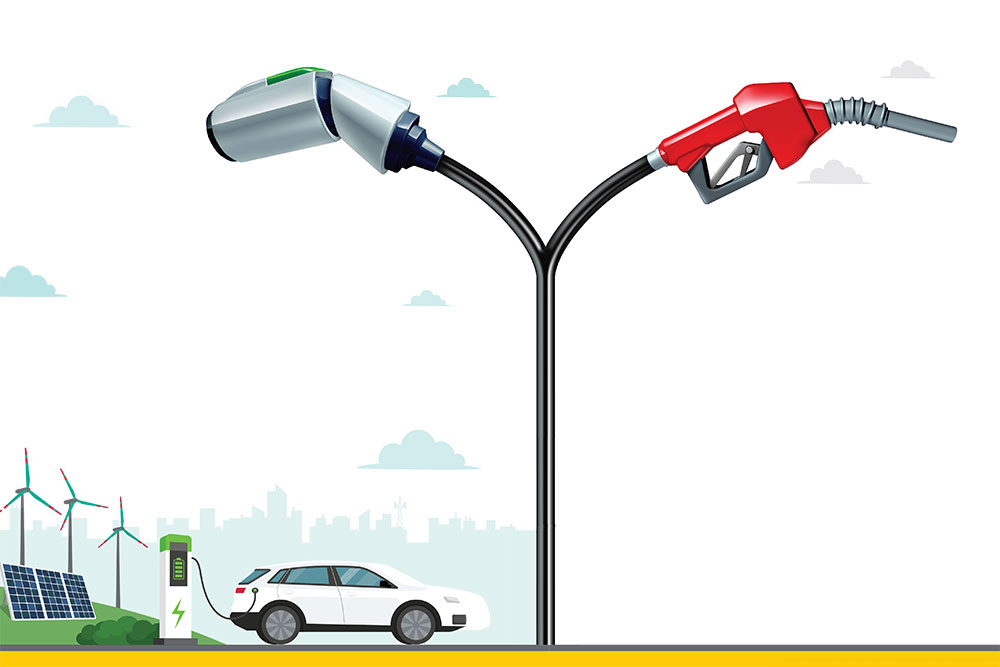Though carmakers have reduced the prices on EVs, they are still costlier than their fossil fuel cousins. Higher prices and infrastructure still affect their popularity
When Elon Musk, the maverick CEO of Tesla Inc. came out with his very futurist-looking boxy Cybertruck in 2019, it heralded the beginning of an era in the automotive industry. It drew the attention of the automotive world to the possibility of the adoption of passenger electric vehicles (EVs) on a wider scale. Until then, the adoption of EVs had primarily been confined to public modes of transport, starting from the days of the Cold War era.
As policies turned green-focused, major automakers across the world indicated that they would be shifting to EVs or a form of hybrid by the 2030s. Some even hinted at stopping further research and production on fossil fuel engines.
The India story
The EV journey in India began with Reva, which was launched in 2001. Nine years later after being acquired by auto major Mahindra and Mahindra (M&M) and a new launch a few years later, the public response, however, remained tepid.
But things have changed a lot since then and there is increased interest in the EV segment. Tata Motors, India’s largest automobile company, has ramped up EV production like none other, including launching SUVs, mid-size, sedan and smaller models as EVs. The existing EV models from the Tata stable are from the Nexon, Punch, Tiago, Tigor line-ups.
Though a few other automakers have jumped on to the EV bandwagon of late, they have mostly been confined to the upper end of the price bracket.
Hyundai came out with the IONIQ5 priced at Rs 45.95 lakh, ex-showroom Mumbai and the Kona priced at Rs 25.30 lakh (ex-showroom India). Kia Motors has the EV6 priced upwards of Rs 60.95 lakh, ex-showroom Mumbai. MG Motors has two models, the MG Comet and MG ZS EV, priced at Rs 6.98 lakh and Rs 18.98 lakh, (ex-showroom, Mumbai) for the base versions.
M&M has one EV model, XUV 400, priced upwards of Rs 15.49 lakh, ex-showroom Mumbai, and plans to launch a few more this year. India’s largest carmaker Maruti Suzuki, plans to launch a few in the EV segment by the year-end priced at Rs 20 lakh and above.
Incidentally, the sales figures of EV four-wheelers in India has grown by leaps and bounds in the last few years—from 5,154 units in financial year 2020-21 to 18,622 units in FY22 to 47,499 units in FY23. The April-February figure for FY24 comes to 81,114, nearly double the FY23 figures, according to data from the Society of Indian Automobile Manufacturers. The sales of EV two-wheelers have catapulted by an even wider margin.


Price Still A Deterrent
Though automakers have reduced the prices on EVs recently, they still cost much more than their petrol or diesel versions. Tata Motors reduced the price of its popular Nexon EVs by as much as Rs 1.20 lakh, but the petrol and diesel versions of Nexon are still cheaper by almost Rs 5 lakh. The base version of another of its popular EV model, the Tiago, costs Rs 7.99 lakh, while the top-end comes at Rs 11.89 lakh, ex-showroom Mumbai. Tata Motors reduced the price on this model by Rs 70,000 recently. In contrast, the base petrol version comes for Rs 5.64 lakh, while the top-end petrol costs Rs 7.29 lakh, lesser than the base EV model.
The Punch, also from Tata Motors, comes for Rs 6,12,900, ex-showroom Mumbai, for the petrol version, while the Punch EV, costs Rs 10.99 lakh upwards for the base version.
The two-door boxy four-seater MG Comet is priced at Rs 6.98 lakh for the base model, ex-showroom Mumbai, while the similar looking larger four-door Maruti Wagon R costs Rs 5.54 lakh, ex-showroom Mumbai. Of course, there’s also the question of the number of kilometres the vehicle can go in a single charge. For MG Comet, the company claims a run of 230 km on a single charge of the 17.3kwh battery.
Suraj Ghosh, vice president, Minus Zero, a tech firm developing autonomous driving technology for vehicles, says that though automakers “slashed prices on their entry-level models to boost sales, the demand did not surge as expected”.
Are EVs Pocket-Friendly?
In such a scenario, should you go for an electric car or continue with a conventional fuel-powered car? We ran calculations for a 1,500 km run per month to give you an idea (see Cost Comparison).
Our calculations show that EVs turn out to be more expensive than petrol and diesel in the first four years. After that the total cost of EVs turn out to be lower than both petrol and diesel cars. But there is a catch. This is assuming that you do not replace the battery even once, which is unlikely.
So, when should you replace the battery? That depends on the battery, the number of charging cycles, the outside temperature and driving style. Rapid acceleration, higher speed and use of air-conditioning and heating will affect the car’s range and require more frequent recharges. Says Ghosh: “There is no test to determine how much the battery will last. Carmakers claim that the original equipment manufacturer (OEM) batteries will last their claimed life. But even if they get weak before that, they will operate at 70-80 per cent efficiency.”
Let’s say you go for a battery change in the fifth year, then your petrol and diesel car will lose out to EV in the eighth and the ninth years, respectively. But should you go for another battery replacement in the ninth year, your EV will have lost the race through 10 years. But add one more year (11th year), and the total ownership cost of the EV will be chepaer than the petrol version.
The Verdict
It’s a 50-50 situation. The price cut on EVs hasn’t quite excited buyers to decisively choose EVs over petrol or diesel cars. They still cost more than either of the two. Says Ghosh: “The higher acquisition cost continues to impede their widespread adoption.”
However, things could change in the near future. The first is battery efficiency as our calculations have shown. A longer battery life will reduce the cost of ownership. The second factor would be increasing the number of public charging facilities.
According to data available on the Niti Ayog e-Amrit website, India has an active network of 934 active public charging stations spread across the length and breadth of the country. In comparison, there are around 70,000 fossil fuel pumps (petrol and diesel) across the country.
Says Manjula Girish, business head-EV charging and photovoltaic inverter division, Delta Electronics, a power and energy management company: “The scarcity of charging infrastructure remains a critical hurdle. Insufficient charging infrastructure in urban areas is a problem as many potential EV owners lack access to home charging options. Also, inadequate charging infrastructure along inter-city highways and major travel routes restricts the feasibility of long-distance EV travel, which also acts as a deterrent towards switching to EVs.”
Adds Ghosh: “Though the infrastructure is increasing, it hasn’t quite reached that level…(where car buyers will buy EVs without considering other fossil fuel options).”
If you were to flip through the pages of any works of Isaac Asimov, HG Wells or Neal Stephenson, the American author who coined the term metaverse, or see any of the several movies on the subject, you will find that most of the vehicles described on the pages or the silver screen display a few common traits. They typically run on electric or other forms of renewable energy, are sleek, and are usually steel, grey or silver in colour. So, was the Tesla Cybertruck the proverbial knock on the door towards such a futuristic mode of transport? Well, it seems cost will remain an impediment, at least for some more time.
s.sanyal@outlookindia.com







